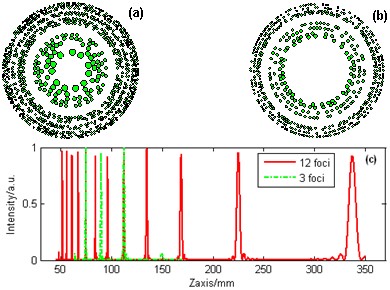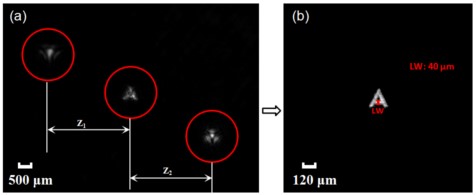Wavefront measurement has various applications in high power amplifiers, adaptive optical system and phase microscopy. Among methods for high-precision wavefront measurement, the coherent diffraction imaging (CDI) is a technique that employs iterative algorithms to reconstruct the phase and amplitude information of the test object from its diffraction intensities. However, it requires multiple exposures of intensity images via mechanical and electrical scanning. Although some researchers used a random phase mask to modulate the wavefront of the laser beam to simultaneously capture required images, the setup cannot be used for x-rays.
Recently, researchers at Shanghai Institute of Optics and Fine Mechanics, Chinese Academy of Sciences, have proposed a method of single-shot CDI based on the multi-focal Fibonacci sieves. The related work was published in Applied Physics Letters.
The previous work showed that for multi-planar CDI the iteration speed and reconstructive precision would be improved with the increase of the intensity measurements. Theon-ladder sieves could produce three-dimensional array diffraction-limited foci. More than ten intensity images could be extracted from the single recording intensity measurement.
In the experiment, researchers designed a kind of multi-focal Fibonacci sieves to simultaneously capture multi-planar images at a single recording plane. In this case, multiple intensity maps would be recorded by a detector in one single exposure. Then, the test object wavefront could be reconstructed by phase-retrieval algorithm.
When the multi-focal sieve was located at the spectrum plane of an imaging system, multiple image planes could be produced at one time. A test object fabricated on a chrome plate was measured successfully to verify the validity of the proposed single-shot multi-planar wavefront measurement with multi-focal sieve.
This method not only meets the requirement of the robust of the measurement system and real-time measurement with the features of real-time, fast speed and easy operation in wavefront measurement, but also takes full advantage of the space-bandwidth product of the optical detector by optimizing the optical design.
Furthermore, amplitude-only multi-focal Fibonacci sieve makes it possible to be applied for x-rays imaging and Terahertz detection in the future.
This work was supported by National Natural Science Foundation of China and Youth Innovation Promotion Association of the Chinese Academy of Sciences.

Fig. 1. Fibonacci sieves of the first 20 underlying rings. (Image by SIOM) 
Fig. 2. Experimental results. (Image by SIOM)
Article website:
https://doi.org/10.1063/5.0010711
Contact:
Mr. CAO Yong
General Administrative Office
Shanghai Institute of Optics and Fine Mechanics, CAS
Email: caoyong@siom.ac.cn